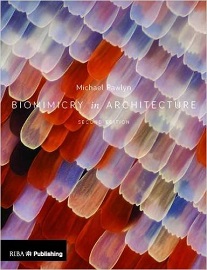Main author
Michael BrooksBiomimicry in Architecture - review
Michael Pawlyn – ‘Biomimicry in Architecture’
Published by RIBA Publishing (2016)
‘Biomimicry in Architecture’, released in its second edition in October 2016, is a thoroughly absorbing and illuminating examination of how biomimicry might transform the built environment.
As an architect who was central to the team that re-invented horticultural architecture for the Eden Project, Michael Pawlyn is perfectly placed to compile a book on biomimicry, being widely regarded as something of a pioneer in the field.
He begins by defining biomimicry as ‘design inspired by the way functional challenges have been solved in biology’. He paints a picture of biological organisms embodying technologies that have benefitted from a 3.8 billion-year research and development period; in comparison with which, humankind can only feel a degree of humility. He explains that we should see biomimicry as being one of the ‘best sources of solutions that will allow us to create a positive future’ and shift from the industrial to the ecological age.
The book benefits from Pawlyn’s clear and engaging writing style, which is translates complex systems into jargon-free explanations. Where jargon is unavoidable, he helpfully unravels it, such as with the definitions and distinctions between biomimicry and, say, biomorphism - more of a ‘formal and aesthetic expression’ rather than the former which is ‘a functional discipline’.
However, the lack of a more detailed theorising of how biomimicry might connect with modernist and post-modernist architecture may disappoint those looking for a way of placing it in the context of these more conventional movements as a viable solution for the future.
Through several ‘how’ rather than ‘why’-based chapters, Pawlyn explores elements such as hollow tubes, skeletons, exoskeletons, webs/tension structures, pneumatic structures, deployable structures, and how they can be replicated in the built environment. The book explores such problems as how buildings can be powered, how to create zero-waste systems, and, most interestingly, how we can manage water by drawing inspiration from creatures such as the Namibian fog-basking beetle.
The real joy of the book though is the bountiful images which, with nature and architecture placed so well next to one another, make the future of biomimicry seem full of wonder and potential. Pawlyn concedes that biomimicry has yet to capture the imagination of the profession as it has in industrial design for instance, but no doubt any architect or designer who picks up this book will come away wondering why and for how much longer?
[edit] Related articles on Designing Buildings
- An Introduction to Passive House - review.
- Bill Gething and Katie Puckett - Design for Climate Change.
- Biomimicry.
- Building Revolutions - review.
- Charles Waldheim - Landscape as Urbanism: A General Theory.
- FutuREstorative - review.
- How Buildings Work - review.
- Manual of Section - review.
- Mimetic architecture.
- Skeuomorphism.
Featured articles and news
Latest Build UK Building Safety Regime explainer published
Key elements in one short, now updated document.
UKGBC launch the UK Climate Resilience Roadmap
First guidance of its kind on direct climate impacts for the built environment and how it can adapt.
CLC Health, Safety and Wellbeing Strategy 2025
Launched by the Minister for Industry to look at fatalities on site, improving mental health and other issues.
One of the most impressive Victorian architects. Book review.
Common Assessment Standard now with building safety
New CAS update now includes mandatory building safety questions.
RTPI leader to become new CIOB Chief Executive Officer
Dr Victoria Hills MRTPI, FICE to take over after Caroline Gumble’s departure.
Social and affordable housing, a long term plan for delivery
The “Delivering a Decade of Renewal for Social and Affordable Housing” strategy sets out future path.
A change to adoptive architecture
Effects of global weather warming on architectural detailing, material choice and human interaction.
The proposed publicly owned and backed subsidiary of Homes England, to facilitate new homes.
How big is the problem and what can we do to mitigate the effects?
Overheating guidance and tools for building designers
A number of cool guides to help with the heat.
The UK's Modern Industrial Strategy: A 10 year plan
Previous consultation criticism, current key elements and general support with some persisting reservations.
Building Safety Regulator reforms
New roles, new staff and a new fast track service pave the way for a single construction regulator.
Architectural Technologist CPDs and Communications
CIAT CPD… and how you can do it!
Cooling centres and cool spaces
Managing extreme heat in cities by directing the public to places for heat stress relief and water sources.
Winter gardens: A brief history and warm variations
Extending the season with glass in different forms and terms.
Restoring Great Yarmouth's Winter Gardens
Transforming one of the least sustainable constructions imaginable.
























